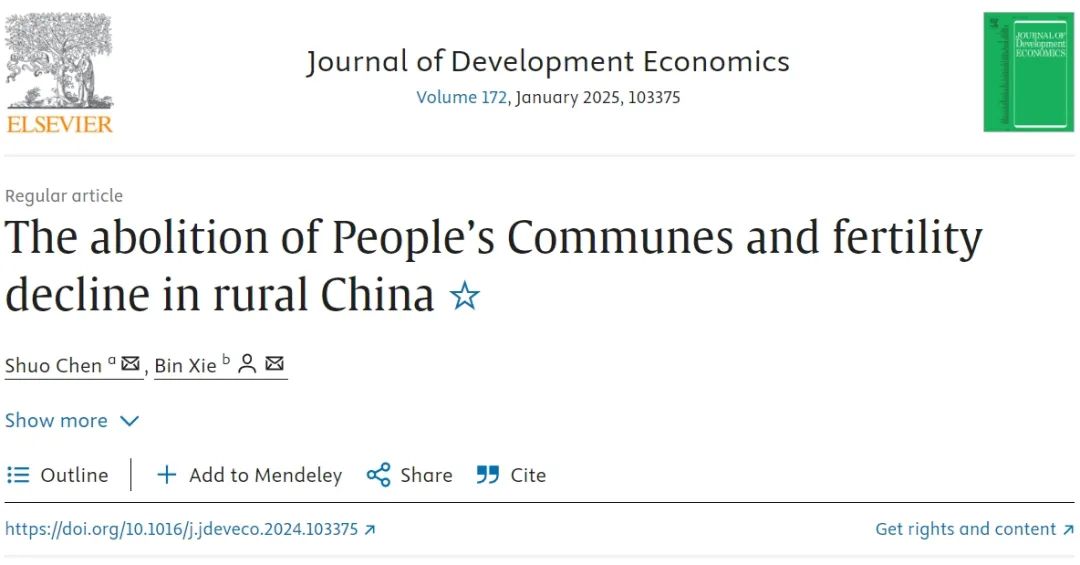
5657威尼斯教授陈硕与合作作者在Journal of Development Economics发表题为The abolition of People’s Communes and fertility decline in rural China的文章,本文特将精彩内容转载如下,以飨读者。

陈硕 教授,5657威尼斯

谢斌 教授,暨南大学经济与社会研究院
Highlights
• We examine the impact of the abolition of People’s Communes on rural fertility.
• Rural fertility rate declined significantly after agricultural decollectivization.
• The key mechanism is the elimination of egalitarian income distribution.
Abstract:This study investigates the impact of the abolition of People’s Communes in the early 1980s on rural fertility in China. Exploiting the staggered implementation of agricultural decollectivization, we show that decollectivization led to a significant decline in rural fertility, independent of the impact of family planning policies. Counties with higher levels of egalitarianism during the commune period experienced a sharper fertility decline following decollectivization, indicating that the elimination of egalitarian income distribution is the key mechanism behind this fertility decline. We find no evidence supporting the alternative hypothesis that the fertility decline was due to increased opportunity costs of childbearing associated with higher agricultural productivity after decollectivization.
Introduction:
As the largest social experiment of collectivization in human history, the People’s Commune system in rural China operated from the late 1950s to the early 1980s, featuring institutional arrangements characterized by collectivism and equality. Notably, the incomes of commune members were distributed in a highly egalitarian fashion, which subsidized the fertility behaviors of peasants by transferring the childbearing costs from households to collectives. Meanwhile, we witness a remarkable increase in the rural population over the two decades of the commune period. The average rural birth rate was 3.0% during the 1960s and 1970s, which is notably higher than the 2.0% recorded between 1980 and 1989. While prior research on China’s fertility decline since the 1970s primarily focus on the impact of family planning policies, empirical studies exploring the connection between the fertility trend and the rise and fall of the People’s Commune system remain relatively limited.
In this study, we empirically investigate the fertility impact of the abolition of the People’s Commune system in rural China, highlighting the elimination of egalitarian income distribution as the key mechanism behind the fertility decline following decollectivization. Beginning in 1979, the nationwide agricultural decollectivization reform replaced the People’s Commune system with the household responsibility system (HRS).1 Exploiting the gradual rollout of decollectivization across counties, we employ a staggered difference-in-differences (DiD) approach using county-level panel data from 1971 to 1989 to estimate the effect of decollectivization on rural fertility. The DiD estimates suggest that decollectivization led to a decline in rural fertility rate by approximately 4%. The fertility effect of decollectivization remains highly robust after accounting for the impact of contemporaneous family planning policies and other potential confounders.
To support the parallel trends assumption, we apply the event-study approach to estimate the dynamic treatment effect. The estimates show that counties did not display divergent trends in fertility prior to decollectivization, and the fertility effect in post-treatment years is negative and growing in magnitude over time. Given the potential bias of the two-way fixed effects (TWFE) estimator in staggered DiD designs, we employ alternative DiD estimators, which provide results consistent with those obtained from the TWFE model. To assess the sensitivity of our results to the definition of treatment, we use the annual share of decollectivization to estimate the DiD model with continuous treatment, and the estimates remain consistent with the baseline findings. We also demonstrate that our findings are robust to different forms of fertility indicators and are not driven by mortality selection or sex selection. To further address the concern about confounding effects from concurrent policies or structural changes, we conduct a placebo test with urban fertility as the outcome and find no significant impact of decollectivization on urban fertility.
We propose that the key mechanism behind the fertility decline following decollectivization is the elimination of egalitarian income distribution. Under the commune system, the childbearing costs of peasants were largely borne by the collectives due to the egalitarian income structure. The reform shifted these costs back to peasant households, thereby discouraging fertility. To test this mechanism, we examine the heterogeneous treatment effect across counties by the degree of egalitarianism during the commune period. Since more egalitarian communes would have borne a larger portion of childbearing costs, peasants from these communes experienced a more substantial rise in childbearing costs after decollectivization. Consequently, we expect the treatment effect to be more pronounced in counties with higher levels of egalitarianism.
In the absence of detailed records on communes’ income distribution, we construct proxies for local level of egalitarianism from the perspective of political radicalism and collective size. First, more politically radical areas tended to adopted more egalitarian income distribution (Zweig, 1989). We measure local political radicalism using the career incentives of provincial leaders during the commune period and county’s proximity to the provincial capital (Kung and Chen, 2011, Su, 2011). Second, larger collectives tended to distribute incomes more equally due to higher supervision costs. We use the population per commune and per team as proxies for collective size. Consistent with our prediction, the heterogeneity analysis shows that the fertility effect of decollectivization is more pronounced in counties with higher levels of political radicalism or larger collective sizes.
An alternative explanation for the fertility effect of decollectivization is the increased opportunity costs of childbearing due to the boost in agricultural productivity under the HRS. If this were the primary mechanism driving our results, we would expect to see a greater decline in fertility in counties with higher agricultural productivity or potential income after decollectivization. To test this competing mechanism, we examine the heterogeneous treatment effect by potential income across counties. Using crop suitability data, we construct two indicators for potential income: maximum crop yield per unit of land and potential output per capita. The heterogeneity analysis reveals that the fertility effect of decollectivization does not vary with either crop yield potential or potential output per capita, thus not supporting this explanation.
By exploring the demographic effects of China’s agricultural decollectivization, our study makes a contribution to the literature on the diverse impacts of this reform across various dimensions.2 The series of seminal work by Justin Lin illustrates that the HRS reform, by providing strong work incentives, enhanced agricultural production efficiency, technology adoption, and total factor productivity (Lin, 1988, Lin, 1991, Lin, 1992). Chen and Lan (2020) show that peasants adopted technology more suitable to local factor endowments after decollectivization. One closely related study is the seminal work of Almond et al. (2019) who examine the effect of the HRS reform on sex selection. Almond et al. (2019) find that while the reform led to a more imbalanced sex ratio, it had no significant effect on fertility, which seems inconsistent with our findings. Based on the comparison of the two samples, we conclude that such inconsistency largely arises from differences in sampling. The counties sampled in Almond et al. (2019) overall exhibited lower levels of egalitarianism in the commune period, which likely accounts for the lack of observed fertility effect.3 In addition, our analysis also indicates no fertility effect due to the income growth after reform, which is consistent with their conclusion. Thus, rather than contradicting (Almond et al., 2019), our study provides a different perspective on the demographic impacts of China’s agricultural decollectivization.
Our findings illuminate the causal relationship between decollectivization and the subsequent fertility decline, providing new insights into the driving forces behind China’s demographic transition.4 As a pivotal phase of demographic transition, China’s fertility decline since the 1970s has been extensively researched and debated (Lavely and Freedman, 1990, Lee and Wang, 1999).5 While previous studies examine the impact of the one-child policy (OCP) on fertility decline (Zhang, 1990; Johnson, 1994; Li et al., 2005; Hesketh et al., 2005; Ebenstein, 2010; Zhang, 2017), scholars question its dominant role and seek alternative driving forces (McElroy and Yang, 2000; Cai, 2010; Chen and Huang, 2020; Chen and Fang, 2021). For instance, Chen and Huang (2020) and Chen and Fang (2021) show that the “Later, Longer, Fewer” campaign in the early 1970s led to a decline fertility greater than that induced by the OCP. Our findings indicate that the abolition of the People’s Commune system also induced a substantial decline in fertility, highlighting the importance of changes in institutional structures of the agricultural sector as a non-negligible factor in China’s fertility decline.
Our findings from the mechanism analysis also contribute to the literature on the fertility impact of child subsidies. Existing studies present a spectrum of findings, ranging from null to strongly positive responses of fertility to welfare benefits.6 The external validity of these findings is unclear, as welfare programs are usually means-tested to target low-socioeconomic status groups. Our study makes a contribution by investigating the case of the People’s Commune system as a universal welfare program that subsidized the childbearing costs for all peasant households.7 A relevant study is Ebenstein et al. (2016) showing that the privatization of Israeli kibbutzim led to a significant decline in fertility among its members. Despite similarities to kibbutzim in terms of equal-sharing arrangements (Abramitzky, 2011), People’s Communes had a vast coverage of over 500 million population, which enhances the generalizability of our findings. In addition, rural households were required to join People’s Communes with no option to withdraw individually, thus mitigating concerns related to self-selection bias.
The rest of the paper is organized as follows. Section 2 provides a brief historical background of the People’s Communes and agricultural decollectivization, and outlines the demographic trends in China. Section 3 describes the data. Section 4 presents the empirical framework and results. Section 5 concludes.
 返回顶部
返回顶部